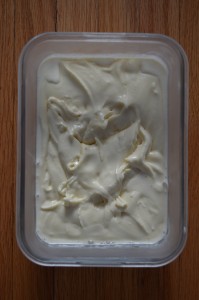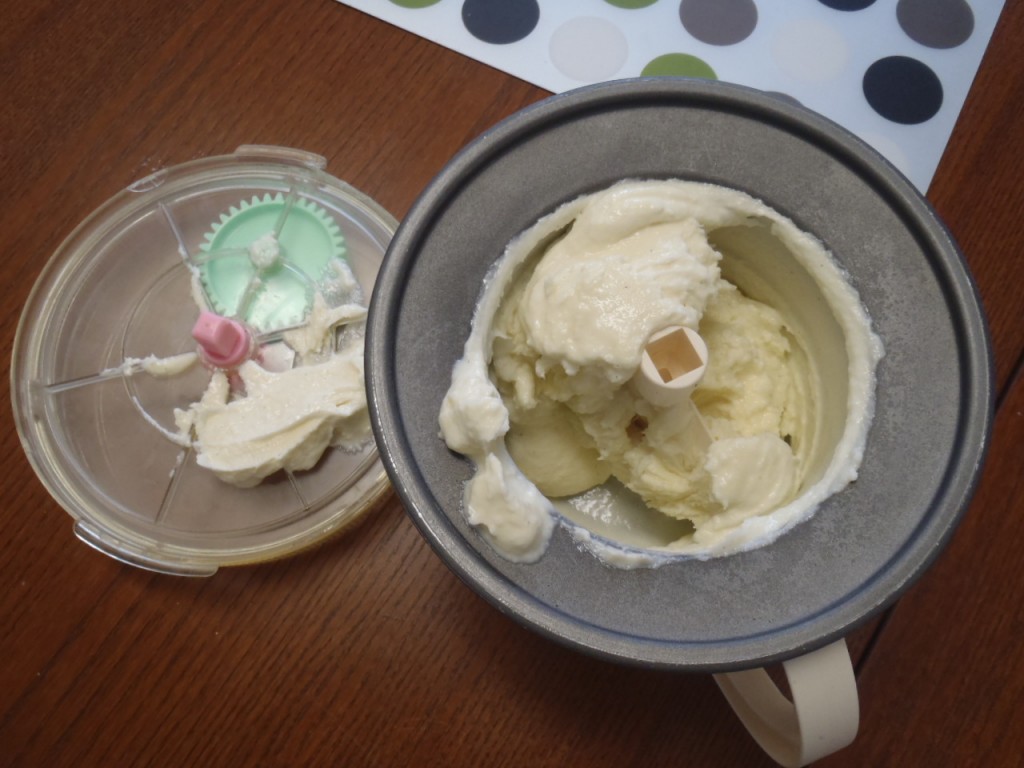 The short version of this post goes like this: remember when we made crème anglaise? That sauce made from milk, cream, and sugar, flavoured with vanilla and thickened with egg yolks, gently cooked on a double-boiler? If you put that sauce into a well-chilled household ice cream churn, you can make pretty good ice cream.
The short version of this post goes like this: remember when we made crème anglaise? That sauce made from milk, cream, and sugar, flavoured with vanilla and thickened with egg yolks, gently cooked on a double-boiler? If you put that sauce into a well-chilled household ice cream churn, you can make pretty good ice cream.
The long version of this post is more like this:
There are two broad styles of ice cream: Philadelphia and French. Philly ice cream typically contains only milk, cream, and sugar, while French ice cream also contains eggs. In fact, the crème anglaise we made last week is very, very similar to some recipes for French ice cream mix. The only difference is that traditionally French ice cream mix would be made with whole milk, without the addition of cream. Even so, if you throw that sauce into a well-chilled household ice cream churn, you can make pretty good ice cream.
Let’s talk about why that is. What are the characteristics of good ice cream? Most folks expect ice cream to be very smooth. The only exception to this statement is Lisa Zieminek, a chick who lives in Edmonton who likes her ice cream just a little bit crystalline. She feels that homemade ice cream lower in egg yolk that is allowed to develop a slightly icy, granular texture feels colder on the tongue and therefore more satisfying. Homemade ice cream high in fat and egg yolk, she continues, as well as commercial ice cream with artificial emulsifiers, both feel waxy on the tongue, and somehow not very cold. Hers is a discriminating palate in ice cream, and men.
Anyways with the exception of that one person everyone prefers ice cream to be smooth. The key to having very smooth ice cream is to prevent the formation of large ice crystals during the freezing process. Fat in the mixture helps in this regard, and in French ice cream the proteins and emulsifiers in the egg yolks also lend a hand.
The texture of the final ice cream is only partly a result of the ingredients themselves: the freezing process is also critical. Actually ice cream is frozen in two-stages, called churning and hardening.
Churning. Churning is stirring the ice cream in a tub in which the walls have been super-chilled. Traditionally this might have been a steel bucket placed in a salted ice bath. Nowadays you can buy cheap ice cream makers that you put in your freezer to chill thoroughly before adding your mix.
The factors that will affect the consistency of the ice cream during churning:
- How rapidly the mixture freezes. The faster the mixture freezes, the smaller the ice crystals, and the smoother the final ice cream. Both the mixture and the churn need to be thoroughly pre-chilled. Continuous stirring speeds freezing by constantly exposing new parts of the mixture to the cold walls of the churn.
- How much air is incorporated by stirring. Constant stirring will also incorporate lots of air and make for a smooth ice cream with a light texture. The volume of the ice cream can actually increase dramatically with constant stirring, mostly due to the incorporation of air. (And possibly because water expands when it freezes?) The percent of volume increase is called the overrun in ice-cream-speak.
Hardening. Eventually the ice cream will become stiff and hard to stir. At this point, though, the sweet treat isn’t actually done, because much of the water content is still liquid. The mixture is then transferred to a freezer for some “quiescent freezing”, that is, freezing without churning. As with the churning process, faster freezing will result in smaller ice crystals and a smoother mouthfeel. I transfer my partially-frozen ice cream to a shallow, pre-chilled container and leave it uncovered in the freezer for a few hours. The image at the top of this post shows the ice cream at this stage. It looks and feels a bit like soft-serve.
After hardening the ice cream should be covered tightly and stored in the coldest part of the coldest freezer available to you. Very cold temperatures will prevent oxidation of the fats and absorption of odours from freezer-mates. Very cold temperatures will also ensure that the ice cream doesn’t partially melt when the freezer door is opened or when it has to sit on the counter for a few minutes. If you melt the edges of your ice cream then return it to the freezer the part that re-freezes will be very coarse and crystalline.
I am thrilled to finally have some info on ice cream on Button Soup. It is the supreme accompaniment to many of the dishes discussed on this site, notably: pouding chômeur, sour cherry pie, pie sticks, and a special dessert that we will discuss tomorrow.
